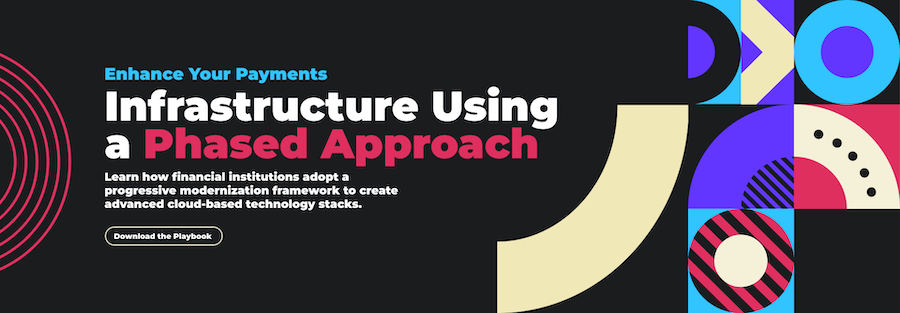What is embedded finance?

Embedded finance is the seamless integration of financial services into non-financial platforms, enhancing customer experience and generating new revenue streams. This future-ready trend is redefining the traditional banking landscape, enabling banking functionalities to be woven into the fabric of digital interactions. This versatile, customer-centric approach is poised to become a significant driver of growth and innovation in the banking industry.
How embedded finance works
Embedded finance is made possible through Application Programming Interfaces (APIs) and Open Banking regulations. APIs are sets of protocols that allow different software systems to communicate with each other, enabling the transfer of data and services between them.
APIs enable non-financial platforms such as ecommerce sites or social media apps to connect with financial institutions' systems and offer banking services to their users. This integration eliminates the need for customers to leave the platform and log in to a separate banking app or website.
Fintech companies develop the necessary technology and software, which are then utilized by non-financial businesses through APIs. This technology allows for the integration of various financial products and services, such as payments, lending, or insurance, directly into the user interface of the non-financial platform.
Embedded finance in action
For example, when you purchase a product on an ecommerce platform, you might have the option to apply for instant credit to finance your purchase. This is an instance of embedded finance. The ecommerce platform, through APIs, connects with a financial institution or a fintech company that can approve and manage the loan. The entire process, from the loan application to the repayment, all happens within the ecommerce platform.
This seamless integration offers users a frictionless experience, eliminating the need to toggle between apps or platforms. It also allows non-financial platforms to increase their revenue by offering value-added services, creating a win-win situation for both businesses and their customers.
![]()
Embedded finance and its impact on traditional banking
The evolution of embedded finance
The concept of an embedded finance offering is not entirely new. Banks have previously partnered with non-financial companies to offer co-branded credit cards or loyalty programs.
However, these collaborations were limited in scope and functioned separately from the core banking services. With the advent of digital transformation and advancements in technology, the embedded finance ecosystem has evolved into a more integrated and sophisticated model.
How Tier 1 banks can adapt to modern challenges
The rise of embedded finance poses a significant challenge for traditional banks, especially Tier 1 banks that have dominated the industry for decades. These banks face fierce competition from fintech companies and neo-banks, which offer more innovative and customer-centric services.
The future of embedded finance
The potential of embedded finance is vast, and it is expected to disrupt the traditional banking landscape in the coming years. As more non-financial platforms incorporate embedded financial services, customers will have access to a wider range of banking functionalities with just a few clicks.
This convenience and accessibility will likely attract more customers, especially the younger generation who value digital experiences. It also opens up opportunities for banks to collaborate with non-financial companies and tap into new markets.
Overall, embedded finance is set to change the way we interact with financial services and drive innovation in the banking industry. Traditional banks must embrace this change and adapt to stay relevant in today's digital era.
The advantages of embracing embedded finance for Tier 1 banks
Embedded finance offers numerous benefits for both traditional financial institutions and non-financial platforms.
Increase revenue
For banks, the embedded finance industry presents an opportunity to tap into new markets and generate additional revenue streams.
By partnering with non-financial platforms, they can offer banking services to a wider range of customers beyond their traditional customer base. This diversification also helps mitigate risks and reduce dependency on traditional banking products, leading to increased profitability.
Banks can extend their services to new demographics and geographical regions through these embedded finance services and partnerships. This allows them to reach a larger customer base and expand their market share without significant investments in physical branches or infrastructure.
Attract existing customers
Embedded finance offers customers a seamless and convenient way to access financial services, making their daily digital interactions more efficient. For example, a user can purchase on an ecommerce platform and select a payment option directly from their bank account without leaving the site. This integration streamlines the payment process and eliminates the need for manual data entry, reducing errors and improving user experience.
Retain your existing customers by offering a more convenient and personalized banking experience. By integrating with non-financial platforms, banks can offer value-added services such as budgeting tools or loyalty programs, enhancing the overall customer experience.
Streamline operations
The use of APIs and digital platforms in embedded banking and finance simplifies processes, reduces paperwork, and enables real-time data exchange. This results in more efficient operations, faster decision-making, and a reduction in operational costs for banks.

How to implement embedded finance in Tier 1 banks
To fully embrace embedded finance solutions, traditional banks must undergo a digital transformation and adopt an agile mindset. Some key steps to implement embedded finance include:
- Developing API capabilities: Tier 1 banks need to invest in robust API infrastructure that can securely connect with non-financial platforms and enable the exchange of data and services.
- Partnering with fintechs & neo-banks: Collaboration with fintech companies and neo-banks allows traditional banks to access innovative technologies and expand their product offerings.
- Prioritizing customer-centricity: Traditional banks must shift their focus from internal processes to providing a seamless and personalized experience for customers. This requires a deep understanding of customer needs and preferences, leveraging data analytics, and continuously improving services.
Modernize your tech stack with Episode 6
E6 understands the importance of continuity and efficiency in the banking sector. To ensure that adoption doesn't disrupt your bank's existing tech stack, E6 employs a progressive modernization approach. This allows your bank to integrate innovative financial services into its existing system in a phased manner, reducing the risks of switching to a new system while allowing you to get to market faster. Contact us today to see how traditional financial institutions can add embedded financial services into their customer offerings.
Frequently asked questions about embedded lending & finance
What is embedded finance?
Embedded finance refers to the seamless integration of financial services into non-financial platforms, providing financial providers and customers with a more convenient and efficient way to access and use these services.
What is embedded lending?
Embedded lending is a subset of the embedded finance market, where lending services are integrated into non-financial platforms. This allows users to apply for and receive loans within the platform they are using, without having to navigate to a separate banking site.
What is embedded insurance?
Embedded insurance is another subset of the embedded finance market, where insurance services are integrated into non-financial platforms. This allows users to purchase and manage insurance policies directly through the platform they are using.
How does embedded lending benefit customers?
Embedded lending provides customers with a more convenient way to access lending services. Customers can apply for loans within the platform they are using, making the process more efficient and user-friendly.
How can traditional banks adapt to the rise of embedded lending?
Traditional banks can embrace embedded finance by undergoing digital transformation, developing robust API capabilities, and partnering with fintech companies. This will enable them to offer more innovative and customer-centric services.
What role does technology play in embedded finance and lending?
Technology, particularly APIs and digital platforms, is a crucial component of finance, and lending. It facilitates the integration of financial services into non-financial platforms, thus enabling real-time data exchange and seamless user experience.
What is the future of embedded finance and lending?
As more businesses recognize the benefits of embedded finance and lending, it is expected that these services will become increasingly common. This will lead to a more integrated and customer-centric financial service landscape.

E6 Team
About the Author
Episode Six provides financial institutions with solutions for legacy payment stacks that aren’t fulfilling the needs of an expanding industry. We are a global provider of enterprise-grade payment technology and ledger management infrastructure for banks that need to keep pace with disruptors and evolving consumer preferences.


